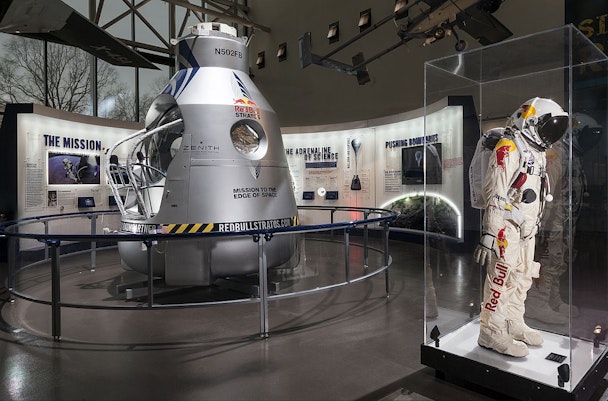Have 'socially shareable' brand experiences gone too far?
Armani launches a pop-up photo opp in NYC’s Oculus. Asics lets visitors livestream a walk through the clouds and post to social media. There are countless other examples of photo-ready brand experiences, all giving visitors the chance to be a social media hero.

Red Bull Stratos exhibit / By Smithsonian Institution [Public domain], via Wikimedia Commons
When it comes to these experiences, brands are smart about turning every selfie into a branding opportunity. They’re consciously directing their audiences without them even knowing it, showing them where to point their cameras, what to crop out, where to stand, and how to maximize their visual impact. This reduces personal choice and focuses on a visitor’s story - which becomes a brand story - and eventually ends up on social media.
But have we really come to terms with how this use of social has affected these experiences?
Social platforms like Instagram have influenced experiential brand marketing in a very specific way. The earliest adopters of brand experience marketing were brands that were inherently experiential - those that make products and services that are only consumed in the experience setting. Nike for athletics and lifestyle. Red Bull for anything you can do while buzzed on caffeine. Auto companies because a car is only as good as your experience on the road. But lately these brand experiences have taken a (potentially dangerous) path towards prioritizing Instagram-ability over actual brand authenticity. Shareability for shareability’s sake can be dangerous for both the experience industry and each brand’s bottom line.
The rush to own experience
Experience offers a combination of one-on-one engagement and brand loyalty that has made experiential the next battleground for consumer attention. That’s why brands are already prepared to pour millions into experience with the promise of higher engagement than banner ads or TV spots. In fact, according to Freeman Global Brand Experience Study, one in three CMOs is expected to allocate between 21 and 50 percent of their budget to brand experience marketing over the next three to five years.
Combine that with social media’s massive (and still growing) user base and it’s no surprise that these companies are on trend to create experiences designed specifically for the generation defined by consumption and sharingof online content. It’s a limitless channel for spreading any message. For example, take Red Bull’s “Stratos" record-setting skydive from 2012. This was not an experience to be attended, it was an experience to be broadcast to the world, with its success measured by its 2.6m social mentions on the first day alone.
But is that what brand experiences are becoming as well? Simply a physical platform from which to broadcast?
While it might be tempting to follow the lead of social media culture, the experience industry needs to realize that brands can’t build real relationships with their audiences if they aren’t maintaining the integrity of the real-life experience. This means creating experiences where the core value is the experience itself, not the social photographic record of it.
A brand has to protect its authenticity of mission and vision to propel it towards success. To do less, not only degrades the intent and quality of the experience, but also undermines the authenticity of the brand itself - for if a brand is willing to settle for “shares” over more meaningful, lasting connections, it’s heading down a troublesome path. Inauthenticity can mean death to a brand when authenticity is only becoming more important to consumers.
More experience, less control
As experiential begins to take up more and more of the marketing spend, it’s important for agencies to remember that there is more to a great brand experience than shares and selfies. Really successful brand experiences are affecting on a deeper level and inspire longer engagement than what comes with shortened social media attention spans.
Of course, beautiful experiences should inspire and motivate. But brands and their partners should also take care. Realize that on social media, a rectangle (or square, in the original manifestation of Instagram) is a slice of the world that curates down everything around it. It deletes the extra and reduces complexity. It also results in an even more reduced, repetitive result. A grid of photos that are all the same: boring and forgotten. For a brand, what could be worse than that?

